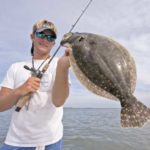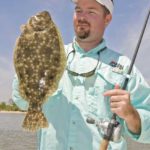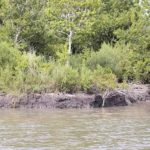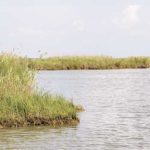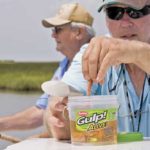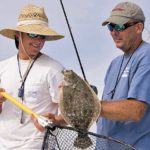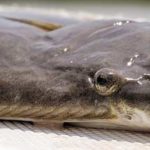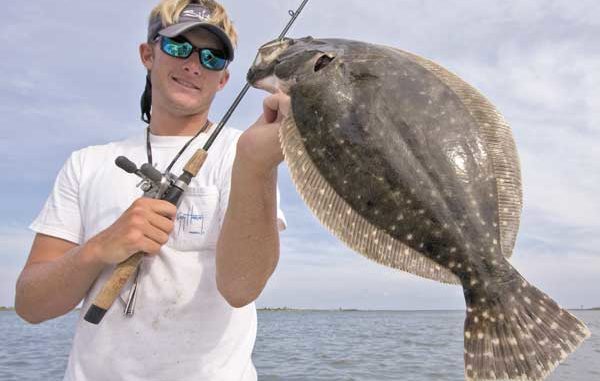
The Calcasieu Ship Channel serves as a bottleneck, where autumn flatfish feast on anglers’ baits during their annual migration.
I’ve been known to drive quite a few miles to get on a good flounder bite. That’s why I immediately picked up my cell phone when I saw a recent picture on the fishing report page at www.lasmag.com. I didn’t know Capt. Tom Adams, the author of the report, but when I saw all those flounder spread out on the trailer in that picture, I knew I had to meet him. He told me he had been on a pretty good flounder bite at Calcasieu Lake, and an invitation to make a trip with him soon followed.
A few days later, I was loading a couple fishing poles and a bucket of 3-inch mew penny-colored Berkley Gulp! Alive! shrimp into Adams’ 24-foot Triton boat. He had informed me over the phone that all I would need is some of those shrimp and something to throw them with. I brought nothing else.
Before we pulled away form Herbert’s Landing, Adams secured a little insurance as he loaded some live shrimp into his baitwell. Before the sun could make its appearance, we were already off on our way to make our flounder fantasies come true.
Adams eventually pulled back on his throttle, and his boat came off plane near one of the most nondescript-looking stretches of bank I had ever seen. I-10 would have looked more appealing than this straight line of what looked to be nothing but bare, exposed mud. My flounder lesson began before I could even get my Gulp! in the water.
“I don’t really know why flounder move to the Gulf of Mexico during the winter,” Adams began. “I’ve been told it’s to spawn, but I don’t know of any studies that point to that for sure.
“What I do know is that all the flounder that had been spending their summers lounging around in Calcasieu Lake will eventually find their way into this Ship Channel.”
And it was along the edge of the Ship Channel where Adams and I began fishing. It was just a little too early for what Adams called the “fall run,” but it was obvious that a few flat fish had already made their way into the approximately 25-mile-long stretch of narrow water.
Like the ships that travel to Lake Charles, flounder have only one way in and one way out whenever they feel the urge to move. This fact alone considerably narrows down the amount of time required to find a few productive flounder holes. Apparently Adams had done his homework and found a really good flounder hole.
“A lot of their movement depends on how cold the water gets,” he said. “If we have a really mild winter, a lot of flounder will stay in the Ship Channel all winter long. I don’t know if there is a magic water temperature that sends them all out into the Gulf of Mexico, but I would definitely stop fishing for them when it got down around 50 degrees.”
With so many miles of Ship Channel to fish, Adams explained that one of his keys to finding the best flounder holes is to ride around and look for baitfish activity on the surface of the water. He stops and makes a cast or two wherever he sees bait flipping close to the shore.
“I would venture to say that nearly half the flounder I catch in any given year come from 1 foot of water or less,” he said. “You would be amazed at just how shallow they get. But if the bait is there, the flounder will be there. I’ve sometimes even found flounder holes by spotting the flounder actually jumping out of that shallow water to chase bait.”
Having found several consistently productive flounder holes up and down the Ship Channel, Adams believes the thing that makes his good ones really good is the location of deeper water near the shallow flats. He really likes to find a spot where he can position his Triton in 5 feet of water to cast into 1 foot.
Although many flounder can be found on the shallowest flat right near the bank, Adams says many of these fish frequently run in the 1- to 2-pound range. To catch the larger fish, he backs off to the deeper drop that is farther out in the channel. Targeting a big flounder is much like targeting a big trout, so Adams rarely spends much time in the deep water.
“There are some places where the Ship Channel stair-steps out into the deep water,” he said. “And you can find some 8-foot flats that drop off into 15 or 20 feet. I think that’s where the bigger fish stay, but you’ve got to commit yourself to fishing for that one or two bites during an entire day of fishing. I like the consistent action of the smaller fish in the shallow water.”
Until Adams and I started pulling in flounder after flounder, I didn’t realize just how many flounder this straight line of water could hold. I had always heard about the fall flounder run at Calcasieu, but I didn’t know it was anything like this.
In fact, Captain Jeff Poe, with whom I shared a boat later that same day, related a pre-gill net story to me.
“This fall run is kind of a historic event,” said the owner of Big Lake Guide Service. “It used to be that just about 50 percent of the state’s total flounder production came from right here.
“I think they had it based on the landings around Calcasieu, but I know there used to be upwards of 100 or so nets from the West Pass/East Pass area down to the beginning of the rocks. There were some caught in shrimp trawls and butterfly nets, but you have to think that the vast majority of them came right from this Ship Channel.”
According to Poe, the flounder migration isn’t something that happens all at once. Rather, it is a gradual process of flounder steadily moving into the channel from its surrounding lakes, bayous and marshes and down into the Gulf of Mexico.
“As good as the flounder bite can be during October,” Poe said, “you could go for a couple days without even getting a bite. Then, all of a sudden, they’ll show up and you can catch them for a few days in a row — then back to nothing. If you’ve found a good spot, and it has bait, the flounder will eventually show up there.”
Finding a good spot with no bait present means looking for either mud or sand banks. Poe explained that anglers can sometimes catch flounder over the oyster reefs, but he favors the mud and sand banks because these are fish that like to bury up on the bottom.
Points and cuts are good places to look, but Poe said he’s done just as well on some very straight banks over the years.
While Adams has caught flounder all up and down the Ship Channel, he pointed out a cut leading into West Bay as being a picture-perfect kind of spot. There are little bayous that run into this cut, and flounder like to feed in the cuts and any of the little bays between the Ship Channel and West Bay.
“Really, any of the points and bays along the channel can hold flounder,” Adams said. “Just recently, I took some customers into a spot where I had caught just a couple fish a couple days before. I didn’t know what to expect, but they wound up whacking 12 flounder in about 30 minutes, and they probably lost 10 more. So here was what I was thinking was going to be a so-so spot, but it turned out to be a great spot.”
As Adams’ anglers found out that day, missing flounder when they bite is an all-too-frequent affair. While it’s impossible to score 100 percent of the time, there are some things anglers can do to hook more flounder than they lose.
Flounder frequently don’t give much of an indication that they’ve grabbed your bait, and they often bite in such a way that all an angler will notice is some kind of heavy or slack sensation through their line. Adams says this usually happens when they pick up your bait and swim right at your boat.
“The best way I can describe these kinds of bites is that they feel like you are dragging a wet rag or some grass,” he said. “I often have to tell customers to set the hook because I’ll see their line isn’t hanging like it should be. If something feels different to you, set the hook.”
Poe, on the other hand, believes anglers miss a lot of flounder because their mouths are made for grabbing and holding. That means your bait sometimes won’t even move in their mouths when you set the hook. In fact, Poe has landed several flounder over the years that were just holding on to the lure.
“It’s kind of like crabbing,” said Poe. “They’ll grab the bait and nothing happens when you set the hook, and every now and then you can pull in a flounder close enough to the boat that you can slip a net under it … the hook will be hanging outside of their mouths.
“That’s why I tend to go to a somewhat stiffer rod than I would use for trout fishing. I usually throw a 7-foot Waterloo HP Slam or Slam Mag when I’m going flounder fishing just so I can get enough backbone to move the hook in their mouths.”
This tendency flounder have to not get hooked is one of the reasons many flounder-specific rigs like the Flounder Pounder have that little drop hook or trailer hook near the end of the plastic.
Another important component to any flounder lure is scent. That’s why Adams prefers the Gulp! Alive! baits. This point was made abundantly clear during my trip with Adams and even clearer as I fished with Poe. The scented plastics were continually getting sucked up by flounder after flounder while other offerings went virtually unnoticed.
“Anybody that’s been flounder fishing a while will tell you the importance of tipping your plastic with a little piece off market shrimp,” Adams said. “That’s because smell is important to these bottom-hugging fish. I’m either throwing the Gulp! stuff, or I’m fishing live bait like finger mullet or pogies.”
Whether fishing scented plastics or live bait, Poe says anglers need to make sure their baits are on the bottom. This can become a difficult task in the Ship Channel’s strong currents, so anglers should use as heavy a weight as needed to get their rigs down.
“It really doesn’t matter if you’re up on a shallow flat with little current,” said Poe. “But when you get in a little bit deeper water, try going up to something like a 3/8-ounce lead head for your plastics and even up to a 1/2-ounce weight on your Carolina rigs, which are better for fishing the live mud minnows, shrimp and mullet.”
Being that flounder fishing means a lot of bottom bumping, Adams says that’s why so many bass anglers are so good at flounder fishing. It’s very much like fishing a Texas-rigged worm on the bottom, and the speed is a lot slower than one might use for tightlining for speckled trout.
For those who aren’t familiar with flounder or bass fishing, Adams hangs his baits under a popping cork.
“I usually only do that if the water is about 2 or 3 feet deep,” he said. “I’m basically still fishing the bait on bottom, but the cork serves as a visual indicator of the flounder bite. I find that inexperienced anglers can hook and land a lot more fish with them than without.”
Both my trips with these two guides produced more than enough flounder to fill a baking pan. In fact, they even produced some for the freezer.
And the good thing is that the action will only get better this month before it tapers off in late November. Like Poe said, “The Ship Channel is just like a big funnel, and that’s the way the flounder have to go.”
Catching flounder in a funnel? Now there’s a fishing fantasy anybody can fulfill.
Contact Capt. Tom Adams at 318-675-9114 or www.fishingtom.net. Contact Capt. Jeff Poe at 337-598-3268 or www.biglakeguideservice.com.
